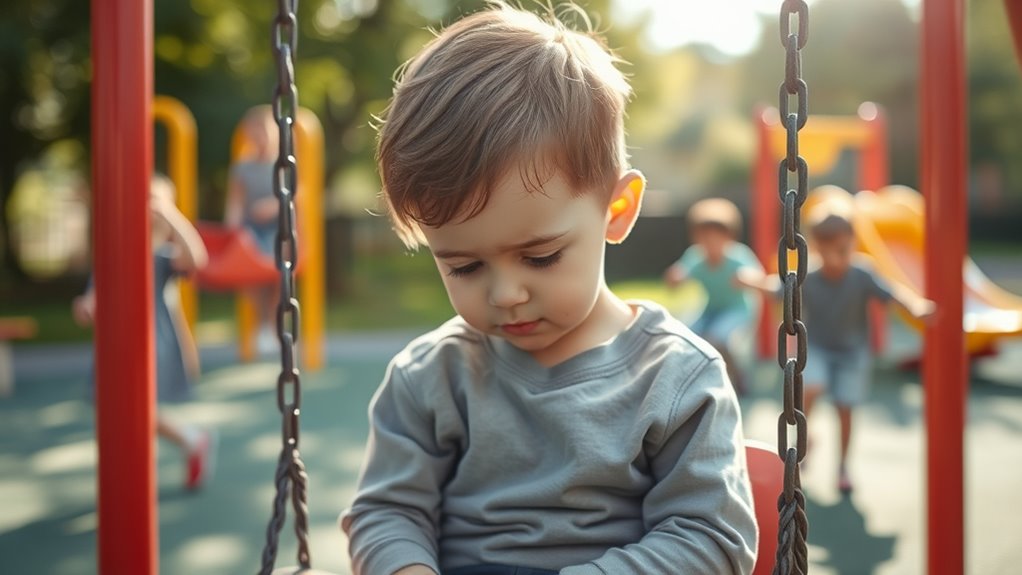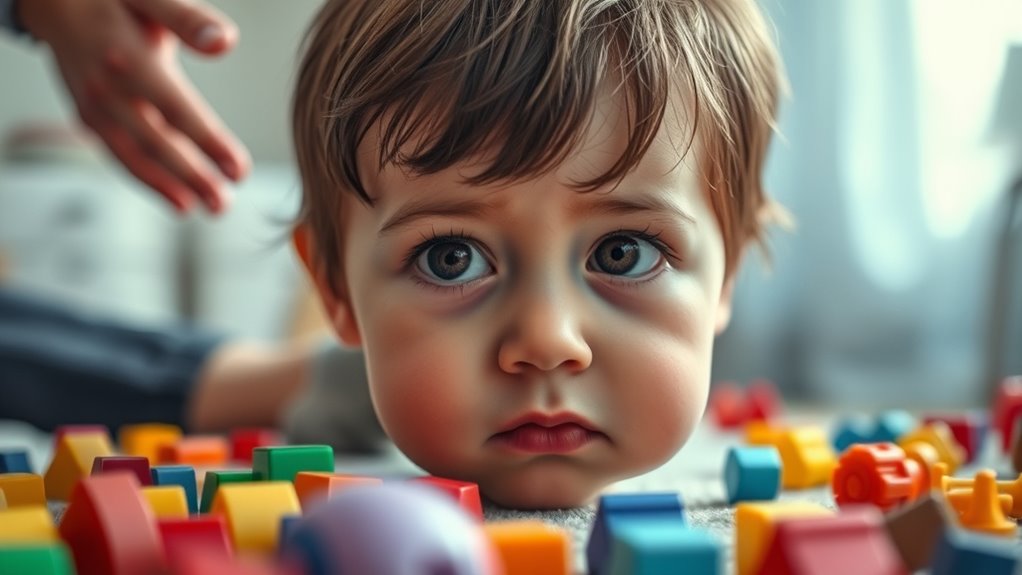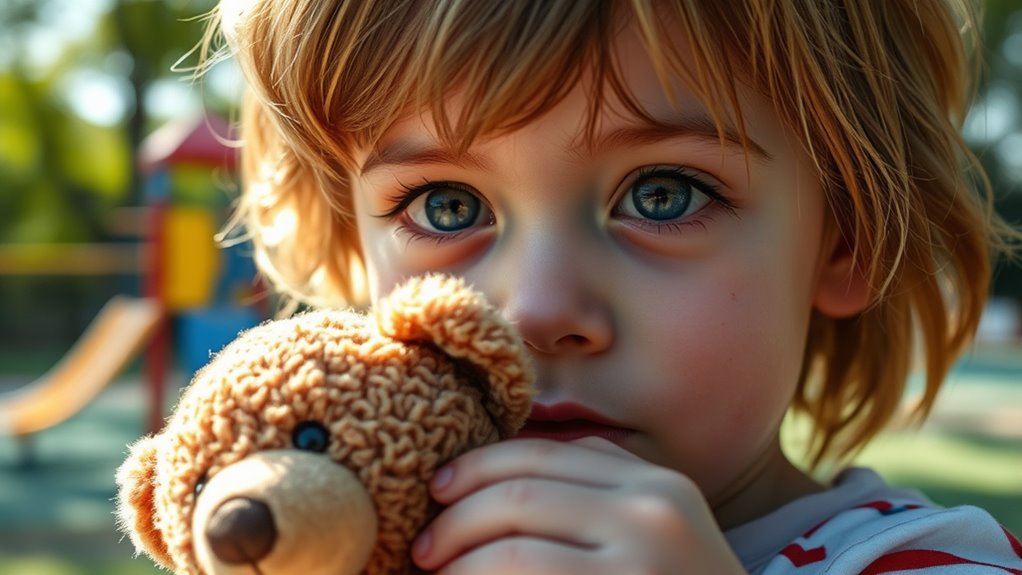Nearly 20% of children in the U.S. face mental health challenges, so recognizing the signs early is essential. Look for mood swings, withdrawal from activities, and declining academic performance. Behavioral changes or physical symptoms like headaches can signal deeper issues. Unfortunately, many kids don’t receive the help they need due to barriers like stigma and access. By observing these signs and seeking assistance, you can make a significant difference. There’s more to discover about supporting your child’s mental health.
Key Takeaways
- Look for emotional signs like mood swings, persistent sadness, or extreme worry as indicators of mental health issues in children.
- Notice changes in social behavior, such as withdrawal from friends or activities, which may signal underlying problems.
- Be aware of behavioral changes, including risky actions or drastic personality shifts, that could indicate mental health concerns.
- Monitor for physical symptoms like headaches or sleep disturbances, as these can be signs of deeper emotional issues.
- Seek professional help if you notice a decline in academic performance or social interactions, as early intervention is crucial.
Prevalence of Mental Health Issues in Children

Nearly 20% of children aged 3-17 in the U.S. face mental health challenges, making it a widespread concern.
Between 2016 and 2023, diagnosed mental or behavioral health conditions among adolescents surged by 35%. Anxiety and depression top the list, with anxiety affecting 16.1% and depression impacting 8.4% of adolescents. Behavior and conduct problems follow, affecting approximately 6.3% of this age group.
Alarmingly, the prevalence of diagnosed pediatric mental illnesses rose by 34.6% from 2012 to 2018. You should be aware that these issues often begin in childhood and can evolve into more severe problems later on. Mental health issues disrupt functioning at home, school, or in social settings, highlighting the importance of early intervention.
Addressing mental health early on can make a significant difference in children’s lives, so recognizing the signs is vital.
Factors Contributing to Mental Health Concerns

Understanding the prevalence of mental health issues in children is just the beginning; identifying the factors that contribute to these concerns is equally important.
Exposure to trauma, such as abuse, neglect, or domestic violence, can greatly impact mental health. Long-term illnesses and the loss of a close family member may also lead to anxiety or depression. Additionally, one in seven adolescents experiences a mental disorder, highlighting the importance of early intervention. Children may also experience symptoms similar to those seen in Borderline Personality Disorder, which can complicate their emotional development. Supporting children through divorce can help mitigate some of these emotional challenges. Creating a supportive environment during these times can be crucial for newborn sleep patterns and overall well-being. The emotional dysregulation exhibited by children can mirror BPD symptoms, making it essential to recognize and address these issues early. Older adults with increased smartphone usage have found that connecting with younger generations through technology can foster understanding and support, which may also benefit children’s mental health.
Family dynamics play an essential role; a stable environment helps, while economic stressors like poverty can exacerbate issues.
Social influences, including social media and peer pressure, are rising concerns. Overuse of social media can lead to stress, and cyberbullying heightens risks.
Finally, school pressures, such as high expectations and bullying, can also negatively affect mental well-being. Recognizing these factors is vital for supporting children effectively.
Signs of Mental Health Issues to Watch For

How can you tell if a child is struggling with mental health issues? Watch for emotional signs like mood swings, persistent sadness, or extreme worry.
Changes in social behavior, like withdrawing from friends or activities, can also be a red flag. You might notice fluctuations in their emotional expression, such as frequent crying or irritability. Mood swings are particularly common during adolescence and can severely impact relationships at home or school. It is crucial to recognize that good grief can be an important aspect of emotional processing if a child experiences loss. Additionally, children from homes with parental infidelity may face heightened emotional distress, which can exacerbate existing mental health issues. The effects of narcissistic abuse on a child’s emotional well-being can also be significant, leading to long-term mental health challenges. Seeking professional help can provide essential support for children navigating these complex emotional landscapes.
Behavioral signs like out-of-control actions, risky behaviors, or drastic personality changes should raise concerns too. Additionally, physical symptoms like headaches or sleep disturbances may indicate deeper issues.
Finally, a decline in academic performance or difficulty with social interactions can signal problems. If you observe any critical red flags, such as self-harm thoughts, seek help immediately for your child’s well-being.
Access to Mental Health Care

Accessing mental health care for children can be challenging, especially when so many families face significant barriers. Nearly 1 in 7 children aged 10 to 19 deal with mental health conditions, yet only about 10% receive treatment. Predictive modeling can play a role in identifying children who may be at risk for mental health issues, allowing for earlier interventions. Additionally, understanding budgeting strategies can help families allocate resources towards mental health care.
Common obstacles include appointment availability, costs, and a lack of services in local areas. If you’re a caregiver, you might find it particularly tough to navigate these issues. Families from lower socioeconomic backgrounds often encounter even greater challenges. Community support can be invaluable in overcoming these barriers and ensuring children receive the help they need. Furthermore, utilizing primitive weapons can foster creativity and resourcefulness, which may help families in crisis situations.
The COVID-19 pandemic exacerbated this situation, increasing the demand for services while availability lagged behind. It’s essential to seek help early, as one-third of mental health conditions appear before age 14.
Prioritizing access to mental health care can make a significant difference in your child’s life. Additionally, seeking professional advice can guide families in navigating the complexities of available resources and support systems.
Strategies for Supporting Mental Health

Supporting your child’s mental health is essential, especially as they navigate the challenges of growing up. Create a supportive home environment with routines and open communication.
Encourage physical activity through sports or outdoor play to boost their mood. Regular exercise has also been linked to improved overall health, including mental wellness. Additionally, engaging in mindfulness practices can help children enhance their self-awareness and emotional regulation. Routine health checks for signs of distress can also be beneficial in identifying any underlying issues early on. It is also important to ensure they have a diet rich in low carb foods, which can positively impact their overall health and energy levels. Model healthy behaviors by demonstrating resilience and teaching coping skills. Foster emotional intelligence by helping them recognize and manage their emotions effectively. Understanding the importance of IECMH is crucial in creating a nurturing atmosphere for your child. Furthermore, incorporating antioxidant-rich foods into their diet can support their brain health and emotional well-being.
Establish trusting relationships by showing warmth and engaging in active listening. Validate their feelings to promote emotional health.
Encourage academic engagement and provide resources for managing stress. Promote a balanced diet, adequate sleep, and mindfulness practices.
Finally, teach relaxation techniques and problem-solving skills, ensuring they’ve effective coping mechanisms for life’s challenges.
Continuing Challenges in Children’s Mental Health

Despite the strategies you can implement to support your child’s mental health, ongoing challenges remain prevalent. Around 20% of children aged 3-17 in the U.S. face mental health disorders each year, with anxiety and behavioral issues being the most common. The impact of biological, cognitive, and social factors on mental health is significant and must be considered when addressing these challenges. Additionally, the importance of professional help cannot be overstated, as it plays a crucial role in managing these disorders effectively.
One key factor that can aid in addressing these challenges is nutrition, which is essential for brain development and can influence emotional well-being. Incorporating foods with antioxidant properties can further support mental health and cognitive function in children. The COVID-19 pandemic worsened these problems, leading to increased rates of depression and anxiety due to social isolation and educational disruptions. Many children struggle to express their feelings, making it difficult to identify issues early on.
Stigmatization and systemic barriers further hinder access to care, especially for marginalized families. Only 53% of children diagnosed receive professional help, emphasizing the need for awareness and action to address these challenges. Understanding the role of healthcare professionals in mental health management is essential for ensuring children receive the support they need.
Staying vigilant and proactive is essential for your child’s well-being.
Future Directions for Mental Health Resources

As the landscape of children’s mental health continues to evolve, it’s crucial to explore innovative resources that can effectively address the growing needs of young people.
You can expect a significant increase in training for mental health professionals, ensuring they’re equipped to meet demand. Schools will enhance support through mental health assessments and treatment services, while pediatric practices will integrate mental health care for extensive support.
You’ll see more community-based services that are stigma-free and accessible. Early intervention strategies will gain traction, helping parents recognize signs of mental health disorders. Furthermore, the integration of pediatric sleep specialists into mental health care will provide comprehensive support for children facing sleep-related issues.
Telehealth options will expand access, and youth-centric services will focus on developmentally appropriate care. Together, these advancements will create a more robust system for supporting children’s mental well-being.
Frequently Asked Questions
How Can I Differentiate Between Normal Stress and a Mental Health Issue?
To differentiate between normal stress and a mental health issue, look for duration and impact.
If you notice anxiety or mood swings that last longer than a few weeks and disrupt daily activities, it might signal a deeper concern.
Watch for withdrawal from friends or family, persistent irritability, or frequent emotional outbursts.
If physical symptoms linger without a clear cause, consider seeking help to guarantee your wellbeing and address any underlying issues.
What Age Should Children Start Receiving Mental Health Education?
You might be surprised to learn that the journey into mental health education should begin as early as preschool.
By ages 3 to 5, children can start understanding emotions, laying the groundwork for deeper knowledge.
As they enter elementary school, they can learn to identify feelings and develop coping strategies.
By middle school, tackle more complex issues.
This early intervention can make all the difference in fostering emotional resilience and well-being throughout their lives.
Are There Specific Signs of Mental Health Issues in Younger Children?
Yes, there are specific signs of mental health issues in younger children. You might notice persistent sadness, mood swings, or sudden fears that disrupt their daily activities.
Behavioral changes can include increased aggression, withdrawal from friends, or major tantrums.
Watch for difficulties in concentration, leading to academic struggles, and physical signs like changes in appetite or sleep disturbances.
Observing these signs early can help you seek the necessary support for your child.
How Can Schools Support Students’ Mental Health Effectively?
As the saying goes, “It takes a village to raise a child.”
Schools can effectively support students’ mental health by fostering a culture of openness, integrating social-emotional learning, and providing safe spaces for discussion.
Training staff to recognize signs of distress is essential, along with partnerships with families and community agencies.
Creating a stigma-free environment encourages students to seek help, ensuring they feel valued and supported throughout their educational journey.
What Role Do Peers Play in Children’s Mental Health?
Peers play an essential role in shaping your child’s mental health. Positive peer relationships can boost their emotional development and encourage healthy behaviors, while negative influences might lead to anxiety or low self-esteem.
When your child interacts with supportive friends, they feel a sense of belonging and acceptance. It’s vital to foster open communication and monitor their peer interactions, ensuring they engage in positive relationships that promote well-being and resilience.
Conclusion
In a world where children should feel safe and joyful, many grapple with hidden mental health struggles. While some kids shine with confidence, others quietly battle anxiety and depression. Recognizing the signs and seeking help can transform lives, offering hope where despair might linger. By fostering open conversations and providing accessible care, we can bridge the gap between silence and support. Together, we can create a brighter future, where every child’s mental well-being is prioritized and nurtured.









